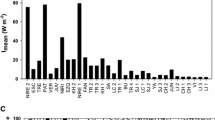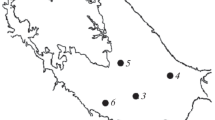Abstract
Monitoring data obtained from 231 freshwater lakes and ponds in the Netherlands, covering the period 1980–1996, were used to analyse the relationships between (a) transparency and chlorophyll-a, and the effect of system characteristics on this relationship, (b) chlorophyll-aand nutrient concentrations, and the effect of biological variables and (c) nutrient concentrations and nutrient loading. (a) Chlorophyll-aimposes a maximum on water transparency, but deviations from this maximum can be large. Reducing chlorophyll-a, therefore, does not guarantee a sufficient improvement of transparency. Soil type and the average depth of a lake were shown to influence the relationship between chlorophyll-aand transparency. (b) The maximum ratios of both chlorophyll-a: total-P and chlorophyll-a: total-N were higher in systems dominated by filamentous cyanobacteria than in systems dominated by other algae, indicating the efficiency of the former group with respect to nutrients. In systems with an areal coverage with submersed macrophytes above 5%, concentrations of chlorophyll-aand nutrients were lower than in systems with lower coverages. The ratios between chlorophyll-aand nutrients were lower at coverages larger than 10%. This indicates both bottom-up and top-down control of algae by macrophytes. Grazing pressure by zooplankton was also found to lower the chlorophyll-a: nutrient ratios. (c) System specific linear relationships were found between the average concentrations of total-P and total-N in the incoming water and the summer mean concentration in the lake. This allows the assessment of admissible loads for individual lakes, with narrower confidence limits compared to traditional relationships based on combined data from many lakes. From the analysis, it is concluded that the chain of relationships from nutrient loading to transparency is complex, and depends on biological variables as well as system characteristics.
Similar content being viewed by others
References
Bierman, V. J., 1976. Mathematical model of the selective enhancement of blue-green algae by nutrient enrichment. In Canale, R. P. (ed.), Modeling Biochemical Processes in Aquatic Ecosystems. Ann Arbor Science Publishers, Michigan, U.S.A.
CUWVO, 1980. Ontwikkeling van grenswaarden voor doorzicht, chlorofyl, fosfaat en stikstof. Resultaten van de tweede eutro-fiëringsenquête (Development of limit values for transparency, chlorophyll, phosphate and nitrogen – results of the second eutrophication survey) RIZA, The Netherlands (in Dutch).
Hosper, S. H., 1997. Clearing lakes – an ecosystem approach to the restoration and management of shallow lakes in the Netherlands. Dissertation Agricultural University Wageningen. ISBN 90-5485-682-3: 168 pp.
Jeppesen, E., P. Kristensen, J. P. Jensen, M. Søndergaard, E. Mortensen & T. Lauridsen, 1992. Recovery resilience following a reduction in external phosphorus loading of shallow eutrophic danish lakes: duration, regulating factors and methods for overcoming resilience. In Giussani, G., L. van Liere & B. Moss (eds)., Ecosystem Research in Freshwater Environment Recovery. Mem. Ist. ital. Idrobiol. 48: 127–148.
Jørgensen, S. E., S. N. Nielsen & L. A. Jørgensen, 1991. Handbook of ecological parameters and ecotoxicology. Elsevier: 1263 pp.
Kirk, J. T. O., 1994. Light and photosynthesis in aquatic ecosystems. Cambridge University Press. ISBN 0521 459664.
Lijklema, L., J. H. Janse & R. M. M Roijackers, 1989. Eutrophication in the Netherlands. Wat. Sci. Technol. 21: 1899–1902.
Meijer, M.-L., I. de Boois, M. Scheffer, R. Portielje & H. Hosper, submitted. Biomanipulation in shallow lakes in the Netherlands: an evaluation of 18 case studies. Hydrobiologia 408/409: 13–30
Portielje, R. & D. T. Van der Molen, 1998. Trend-analysis of eutrophication variables in lakes in the Netherlands. Wat. Sci. Technol. 37: 235–240.
Preisendorfer, R. W., 1986. Secchi disk science: visual optics of natural waters. Limnol. Oceanogr. 31: 909–926.
Schreurs, H., 1992. Cyanobacterial dominance – relations to eutrophication and lake morphology. Dissertation Univ. of Amsterdam: 198 pp.
Schriver, P., J. Bogestrand, E. Jeppesen & M. Søndergaard, 1995. Impact of submerged macrophytes on fish-zooplanktonphytoplankton interactions: large-scale enclosure experiments in a shallow eutrophic lake. Freshwat. Biol. 33: 255–270.
Van den Berg, M. S., H. Coops, M.-L Meijer, M. Scheffer & J. Simons, 1998. Clear water associated with a dense Chara vegetation in the shallow and turbid lake Veluwemeer, The Netherlands. In Jeppesen, E., M. Søndergaard, M. Søndergaard & K. Christoffersen (eds), The Structuring Role of Submerged Macrophytes in Lakes: 339–352.
Van der Molen, D. T. & P. C. M. Boers, 1993. Influence of internal loading on phosphorus concentration in shallow lakes before and after reduction of the external loading. Hydrobiologia 275/276: 379–389.
Van der Molen, D.T. & R. Portielje, 1999. Multi-lake studies in the Netherlands: trends in eutrophication. Hydrobiologia 408/409: 359–365
Vollenweider, R. A., 1976. Advances in defining critical loading levels for phosphorus in lake eutrophication. Mem. Ist. ital. Idrobiol. 33: 53–83.
Wium-Andersen, S., U. Anthoni, C. Cristopherson & G. Houen, 1982. Allelopathic effects on phytoplankton by substances isolated from aquatic macrophytes (Charales). Oikos 39: 187–190.
Zevenboom, W., A. Bij de Vaate, & L. R. Mur, 1982. Assessment of factors limiting growth rate of Oscillatoria agardhiiin hypertrophic Lake Wolderwijd, 1978, by use of physiological indicators. Limnol. Oceanogr. 27: 39–52.
Author information
Authors and Affiliations
Rights and permissions
About this article
Cite this article
Portielje, R., Van der Molen, D.T. Relationships between eutrophication variables: from nutrient loading to transparency. Hydrobiologia 408, 375–387 (1999). https://doi.org/10.1023/A:1017090931476
Issue Date:
DOI: https://doi.org/10.1023/A:1017090931476




